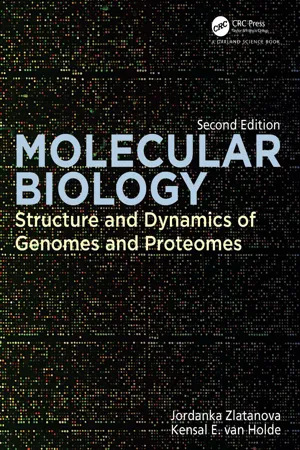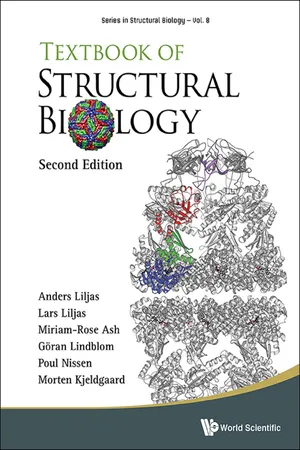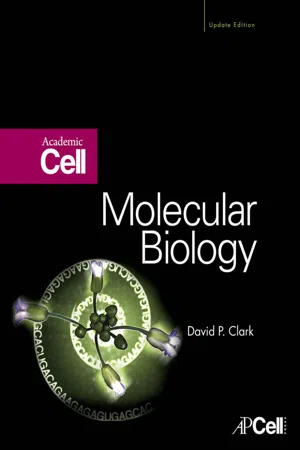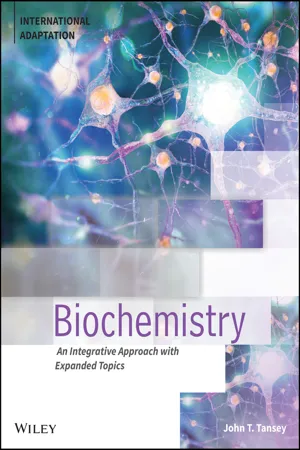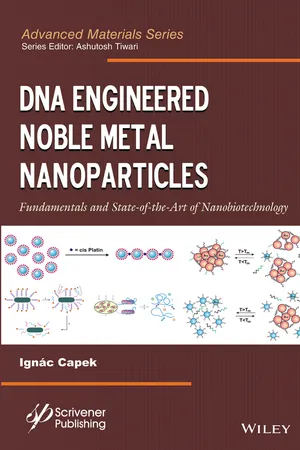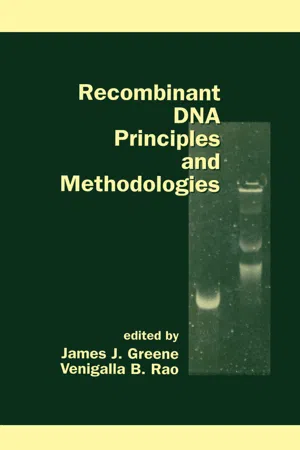Biological Sciences
Nucleic Acids
Nucleic acids are biological macromolecules that store and transmit genetic information in living organisms. They are made up of nucleotide monomers, which consist of a sugar, a phosphate group, and a nitrogenous base. The two main types of nucleic acids are DNA (deoxyribonucleic acid) and RNA (ribonucleic acid), both of which play crucial roles in the functioning of cells and inheritance.
Written by Perlego with AI-assistance
Related key terms
10 Key excerpts on "Nucleic Acids"
- eBook - ePub
Molecular Biology
Structure and Dynamics of Genomes and Proteomes
- Jordanka Zlatanova(Author)
- 2023(Publication Date)
- Garland Science(Publisher)
Nucleic AcidsDOI: 10.1201/9781003132929-4Learning objectivesInformation storage and transmission involve two kinds of Nucleic Acids: ribonucleic acid (RNA) and deoxyribonucleic acid (DNA). Nucleic Acids are polymers built on a repetitive backbone of sugar moieties linked by phosphodiester bonds. In RNA the sugar is ribose; in DNA the sugar is 2′-deoxyribose. Attached to each sugar is a basic unit, either a purine or a pyrimidine. In DNA, the purines are adenine (A) and guanine (G), and the pyrimidines are cytosine (C) and thymine (T); in RNA uracil (U) substitutes for T. The sequence of bases along the polynucleotide chain provides the information for protein structure. Here, we present the Watson and Crick double-helical structure of the DNA, with base pairing of A with T and G with C in the complementary strands. This structure of DNA allows for copying and information transfer from one cell generation to the next.We also describe the possible structures of circular DNA molecules, introducing the concepts of supercoiling and linking number, Lk, the total number of times one strand crosses the other. We also introduce the classes of enzymes (topoisomerases) that can change the linking number of DNA molecules in the cell.RNA molecules are usually found in vivo as single-stranded molecules that have been copied (transcribed) from one strand of genomic DNA. RNAs are intermediaries in the transfer of genetic information from DNA to proteins. They can also perform many other functions, from regulation of transcription to the enzyme functions of ribozymes.4.1 Introduction
Protein sequences are dictated by Nucleic Acids
We have seen that proteins, in their enormous variety, can play a host of roles in the cell, both structural and functional. Each protein accomplishes this by having a unique amino acid sequence, which determines its secondary, tertiary, and quaternary structures. The information that dictates these sequences must somehow be stored in the cell, expressed in proteins, and transmitted through generations of cells and organisms. These vital functions are provided by biopolymers called Nucleic Acids, or polynucleotides, of which there are two kinds: ribonucleic acid (RNA) and deoxyribonucleic acid (DNA - eBook - ePub
Biomolecules
From Genes to Proteins
- Shikha Kaushik, Anju Singh(Authors)
- 2023(Publication Date)
- De Gruyter(Publisher)
Chapter 5 Nucleic AcidsThe versatility and elegant simplicity of DNA (deoxyribonucleic acid) double helix dictate life. Although, nucleic acid was first identified as ‘nuclein’ by Friedrich Miescher, a Swiss physician and biologist in 1869, yet it took more than 70 years to demonstrate that it is the molecule that carries genetic information. DNA of a single cell contains all genetic information necessary for processes of life. The double-helical structure of DNA was discovered by James D. Watson and Francis H. C. Crick in 1953, using the X-ray diffraction data of Rosalind Franklin, and this marvelous discovery proved to be the significant turning point that paved the way to the development of biomedical science and modern biology. Structurally, DNA is a flexible molecule which can adopt numerous unusual structures depending on the solution conditions. To understand the structure of B-form of DNA (natural/native form), it is important to understand the individual components of DNA. Nucleic Acids (DNA and RNA (ribonucleic acid)) are long linear polymers which are made up of monomer units called nucleotides. All nucleotides are made up of three components: a nitrogen heterocyclic base, a pentose sugar, and a phosphate group. They are termed as Nucleic Acids because they are found in nucleus and comprise phosphoric acid (phosphate) as one of its components. The two types of Nucleic Acids that occur in cells are DNA and RNA. DNA acts as a carrier of genetic information and is found in the nucleus of the cell, whereas RNA is present in both the nucleus and cytoplasm.5.1 Components of Nucleic Acids
Both DNA and RNA are biopolymers, which are made up of monomer units called nucleotide. Nucleotide is the building block of Nucleic Acids which consists of three components: - eBook - ePub
The Components of Life
From Nucleic Acids to Carbohydrates
- Britannica Educational Publishing, Kara Rogers(Authors)
- 2010(Publication Date)
- Britannica Educational Publishing(Publisher)
CHAPTER 1Heritable Components: Nucleic AcidsA ll life on Earth is composed of a basic set of chemical components. The most fundamental of these are water (H2 O), charged particles known as ions, and small molecules, namely, Nucleic Acids, amino acids, fatty acids, and carbohydrates. Small molecules are of special significance in understanding the structure, function, and behaviour of living things, particularly because they have such enormous influence on the biochemical phenomena—from genetically programmed activities to physical appearance—that characterize organisms. Of the small molecules, Nucleic Acids are among the most fundamental. They combine to form an organism’s genetic code; therefore, they determine an organism’s genetic makeup, which in turn governs physical makeup. Nucleic Acids are also the molecules of evolution, susceptible to change in response to environmental factors, thereby enabling adaptation and survival.The information locked in the genetic code of Nucleic Acids is translated into amino acids, a molecular form that renders genetic information more accessible to cells. Amino acids, which are defined chemically by the presence of an amino group, which is made up of a nitrogen atom and two atoms of hydrogen (-NH2 ), as well as carbon (C) and oxygen (O), join together to form proteins, with the sequence in which they join being a direct translation of the sequence of the Nucleic Acids from which they were formed. Proteins, because they inherit the nitrogen (N) molecules of amino acids, are characterized as nitrogenous compounds. They are an extraordinarily diverse group of molecules and serve many different functions within cells, from providing structural support to communicating information about regulatory processes and other cellular activities.In contrast to proteins, carbohydrates do not contain nitrogens. Rather, they are formed from various arrangements of carbon, hydrogen, and oxygen. While carbohydrates provide important structural functions in cells, they are better known as the primary sources of energy utilized by most life-forms. Fatty acids, or lipids, form a secondary energy source for many organisms. These molecules, although composed of the same basic elements as carbohydrates—carbon, hydrogen, and oxygen—are distinguished by the linkages, or bonds, connecting the elements. The unique bonding and chemical arrangement of fatty acids determines the molecules’ function and metabolism. - eBook - ePub
- Anders Liljas, Lars Liljas;Miriam-Rose Ash;G?ran Lindblom;Poul Nissen;Morten Kjeldgaard(Authors)
- 2016(Publication Date)
- WSPC(Publisher)
5Basics of Nucleic Acid Structure
Nucleic Acids, also known as polynucleotides, are linear polymers composed of nucleotide monomers. The polynucleotide backbone is composed of a backbone of fivecarbon sugar units connected through phosphate groups. To each sugar unit a purine or a pyrimidine molecule is attached. These are called bases, a term stemming from the acid-base properties of these molecules. There are two main classes of polynucleotides essential to all forms of life, deoxyribonucleic acid (DNA) and ribonucleic acid (RNA).DNA stores the genetic information of the cell in a varying sequence of four bases: adenine (A), thymine (T), guanine (G) and cytosine (C). This sequence is converted into functional protein molecules in the translation process (Chapter 11 ), using rRNA molecules as temporary copies of specific sections of the DNA. These working copies of genes or groups of genes are called messenger rRNA (mRNA) because they act as messengers between the DNA molecule and the translation machinery, and they also serve as messengers for the metabolic state of the cell (Chapter 10 ).rRNA molecules can also store genetic information, for example, in some viruses, but rRNA has important roles in other processes as well. The most central metabolic processes involving Nucleic Acids are replication, transcription and regulation. They all depend upon the recognition of the nucleic acid sequence information by proteins. Thus, it is important to understand the structural properties of DNA and rRNA in order to see the possibilities for biologically relevant interactions between the Nucleic Acids and proteins.On April 25th , 1953, three papers appeared back-to-back in the Journal, Nature. Two of them contained the experimental data and results of diffraction experiments on DNA fibers. The first of the three — and the most famous — is the short paper by Watson and Crick with the title “A Structure for Deoxyribose Nucleic Acid”. At the time it was known that DNA consists of nucleotide units connected through their phosphate groups, but the overall conformation of the so-called sugar-phosphate backbone was unknown. Watson and Crick did not carry out any experiments of their own, but they did get information from X-ray fiber diffraction photographs resulting from experiments carried out by the authors of the other two papers, most notably the famous “Photo 51” (Figure 5.1 - eBook - ePub
- David P. Clark(Author)
- 2009(Publication Date)
- Academic Cell(Publisher)
Chapter Three
DNA, RNA and Protein
Nucleic Acid Molecules Carry Genetic Information Chemical Structure of Nucleic Acids DNA and RNA Each Have Four Bases Nucleosides Are Bases Plus Sugars; Nucleotides Are Nucleosides Plus Phosphate Double Stranded DNA Forms a Double Helix Base Pairs are Held Together by Hydrogen Bonds Complementary Strands Reveal the Secret of Heredity Constituents of Chromosomes The Central Dogma Outlines the Flow of Genetic Information Ribosomes Read the Genetic Code The Genetic Code Dictates the Amino Acid Sequence of Proteins Various Classes of RNA Have Different Functions Proteins, Made of Amino Acids, Carry Out Many Cell Functions The Structure of Proteins Has Four Levels of Organization Proteins Vary in Their Biological RolesNucleic Acid Molecules Carry Genetic Information
Chapter 1 discussed how the fundamentals of modern genetics were laid when Mendel found that hereditary information consists of discrete fundamental units now called genes. Each gene is responsible for a single inherited property or characteristic of the organism. Just as the discovery that atoms are made of subatomic particles ushered in the nuclear age, so the realization that genes are made up of DNA molecules opened the way both to a deeper understanding of life and to its artificial alteration by genetic engineering.Genetic information is encoded by molecules named Nucleic Acids because they were originally isolated from the nucleus of eukaryotic cells. There are two related types of nucleic acid, deoxyribonucleic acid (DNA) and ribonucleic acid (RNA) - eBook - ePub
Biochemistry
An Integrative Approach with Expanded Topics
- John T. Tansey(Author)
- 2022(Publication Date)
- Wiley(Publisher)
• Genetic traits, coded for by deoxyribonucleic acid (DNA) or ribonucleic acid (RNA), are conserved throughout evolution. Small, gradual changes in these coding sequences can be tracked through history to generate an evolutionary family tree.Structure determines function.• DNA molecules are made up of base pairs and have information coded within those base pairs.• The structure of DNA helps to explain how complex phenomena such as DNA replication occur, and how proteins interact with DNA (either specifically or nonspecifically) to organize DNA and regulate function.• RNA molecules can have complex structures that can encode information, regulate gene expression, or act catalytically.Biochemical information is transferred, exchanged, and stored.• Both DNA and RNA can serve as repositories of information that can be stored, translated into another type of molecule (RNA or protein), and transmitted to future generations.Biomolecules are altered through pathways involving transformations of energy and matter.• The nucleotide building blocks of RNA are used by the organism as a source of energy in numerous other chemical reactions.2.1 Nucleic Acids are the Genetic MaterialsNucleic Acids exist as long linear or circular macromolecules in the form of DNA and RNA made of linked nucleotides. The most striking feature of these molecules is that they carry the essential genetic information that directs the functions of a cell.Cell nucleus was recognized to play a major role in inheritance during the late 1870s, based on the observations that male nuclei and female reproductive cells fertilize by undergoing fusion. Subsequently, thread-like entities called chromosomes were found inside the cell when stained with certain dyes. In the late 1900s, the chromosomes were found to be the promising material for carrying genes and their features suggested an interrelationship with DNA. The presence of DNA in chromosomes was observed using special stains. In addition, several types of chromosomal proteins with varying amounts were found across various cell types in contrast to the amount of DNA that remained constant. In higher organisms, all of the DNA present in cells was found in the chromosomes. These findings were insufficient to establish DNA as the genetic material due to insufficiency in the chemical diversity that was required in genetic material. Contrastingly, as proteins existed in diverse forms, these were widely accepted as genetic material with an assumption of DNA being destined to function as structural support to the chromosomes. These assumptions were finally rectified by experiments carried out by Griffith and other scientists to prove that DNA is the genetic material. - eBook - ePub
DNA Engineered Noble Metal Nanoparticles
Fundamentals and State-of-the-Art of Nanobiotechnology
- Ignác Capek, Ashutosh Tiwari(Authors)
- 2015(Publication Date)
- Wiley-Scrivener(Publisher)
Chapter 2Nucleic Acids
2.1 DNA/RNA Basics
Deoxyribonucleic acid (DNA) is the key molecule of life. It is a molecule that encodes the genetic instructions used in the development and functioning of all known living organisms and many viruses. DNA is a nucleic acid; alongside proteins and carbohydrates, Nucleic Acids compose the three major macromolecules essential for all known forms of life. In this genomic age, DNA is well known as a keeper of information—a sort of hard drive for the cell—and much effort has gone into understanding how that information is coded, read, and copied. But DNA is also a physical object and, given its importance, all organisms must carefully manage it. Thus every organism has developed a set of physical strategies that directly ignore DNA’s information content, but are necessary to properly place the DNA for later information-laden interactions. These strategies involve the uptake [63] and packaging [64] of DNA molecules.The discovery of the structure and function of DNA triggered a great boom in life science. DNA consists of two strands which coil around each other to make a “double helix” [65] (Scheme 2.1 ). The two DNA strands are known as polynucleotides since they are composed of simpler units called nucleotides. The sense of wrapping of these two strands is usually clockwise. If we uncoil the two strands, then each strand may be seen to consist of a series of units called “nucleotides.” These are linked to one another with a certain “directionality,” known technically as “5-prime to 3-prime,” in a head-to-tail sense.Scheme 2.1DNA double helix, a double spiral containing two chains of DNA, with base pairs as short vertical lines [65].The three parts of a nucleotide are its sugar (deoxyribose or ribose), phosphate, and purine or pirimidine base. Nucleotide blocks form a spiral or helix on account of the low solubility of the bases in water. Each nucleotide is composed of a nitrogen-containing nucleobase—either guanine (G), adenine (A), thymine (T), or cytosine (C)—as well as a monosaccharide sugar called (deoxy)ribose and a phosphate group. The nucleotides are joined to one another in a chain by covalent bonds between the sugar of one nucleotide and the phosphate of the next, resulting in an alternating sugar-phosphate backbone. According to base-pairing rules (A with T and C with G), hydrogen bonds bind the nitrogenous bases of the two separate polynucleotide strands to make double-stranded (ds)DNA. The oil-soluble bases are transferred to water soluble ones by attaching a sugar and a phosphate which then form a “nucleotide,” which is the building block of DNA or ribonucleic acid (RNA). For such a molecule to be stable in water at neutral pH, the bases will have to tuck themselves into the very center of some folded structure, so as to avoid the water; while the sugars and phosphates, both of which are soluble in water, will have to be on the outside. On the other hand, bases will be situated in the inside (in the core of the DNA structure). - eBook - ePub
mRNA Therapeutics
Fast-to-Market Strategies
- Sarfaraz K. Niazi(Author)
- 2022(Publication Date)
- CRC Press(Publisher)
2 Understanding Nucleic Acids
DOI: 10.1201/9781003248156-32.1 Background
The human body produces thousands of proteins in the trillions of body cells continuously (Figure 2.1 ).These proteins are needed for our survival. So, each cell has a nucleus within which lies 21 chromosomes that are a long-twisted chain of DNA (deoxyribonucleic acid) made up of nucleotides.FIGURE 2.1 Genetic coding to manufacture proteins in the body.The nucleotides are the monomers of Nucleic Acids (Figure 2.2 ).Nucleotides contain either a purine or a pyrimidine—two significant groups of bases. The three building blocks of nucleic acid are:FIGURE 2.2 Nucleic acid structure.- A five-carbon sugar
- A phosphate group
- Nitrogen-containing base. The nitrogen-containing bases (or just base) come in five types—Adenine (A), Uracil (U), Guanine (G), Thymine (T), and Cytosine (C). The base U in RNA gets replaced with T in DNA.
A and G are purines, while U, T, and C belong to the pyrimidine group. Purines and pyrimidine are the nitrogen-containing bases found in the nucleotides of DNA and RNA. They have been artificially synthesized. All the bases (Figure 2.2 ) are nearly two-dimensional flattish rings and, therefore, stackable; due to these shapes, they can form hydrogen bonds only on the plane of this paper. G and A are larger than T and the other base—uracil. Thymine (T) of DNA is replaced with Uracil (U) (Figure 2.1 ) in the RNA base sequence. Uracil misses a methyl group (CH3 ) present in thymine (Figure 2.3 ).FIGURE 2.3 Structure of Nucleic Acids purine and pyrimidine.In a living organism, nucleotides function to create, encode, and store information. The encoded information is contained and conveyed via the nucleic acid sequence. Strings of nucleotides are linked to form the sugar-phosphate backbone of a nucleic acid. The backbone of DNA covers two chains forming a stable helical structure. On the other hand, the RNA backbone is formed out of a single chain, and its structure displays a set of structural motifs (loop, turn, etc.). The deoxyribonucleic acid (DNA) has deoxy sugars in its molecule, meaning that it is derived from the sugar ribose by losing an oxygen atom. This shape shows how the bases stick out and occupy the same plane. - eBook - ePub
- James Greene(Author)
- 2021(Publication Date)
- CRC Press(Publisher)
2Biochemistry of Nucleic Acids
Paul S. Miller Johns Hopkins University, Baltimore, MarylandI. CHEMICAL STRUCTURE AND PROPERTIES OF Nucleic Acids
A. Chemical Structure
Nucleic Acids are high molecular weight macromolecules that form the genetic material of all living organisms. Two types of Nucleic Acids are generally encountered: deoxyribonucleic acid (DNA) and ribonucleic acid (RNA). DNA serves as the repository for genetic information for both procaryotes and eucaryotes. RNA serves a functional role in the conversion of genetic information into cellular proteins, and in the case of certain viruses it serves as the genetic material as well.The Nucleic Acids can be considered as polymers of deoxyribo- or ribonucleotides. The basic structures of DNA or RNA in their single-stranded forms and the numbering system used to designate the various atoms are shown in Figure 1 . Each nucleotide unit is composed of a nitrogenous heterocyclic base, a sugar residue, and a phosphate group. The heterocyclic bases are either six-membered pyrimidine rings or nine-membered purine rings. Two types of purines and two types of pyrimidines are found in Nucleic Acids. Both DNA and RNA contain the purines adenine and guanine. DNA contains the pyrimidines cytosine and thymine, whereas RNA contains the pyrimidines cytosine and uracil. In addition to the four common bases, RNA also contains a number of unusual bases such as 4-thiouracil, thymine, 7-methylguanine, 6, 6-dimethyladenine, and hypoxanthine. These unusual bases are generally found in transfer RNA (tRNA) and in mRNA. With the exception of 5-methylcytosine, DNA contains almost exclusively the four common heterocyclic bases.The heterocyclic bases are linked to the sugar via an N-glycosyl bond. The resulting compound is called a nucleoside. Nucleosides found in DNA contain D-2′-deoxyribose sugars in the furanose form, whereas those in RNA contain D-ribose sugars in the furanose form. In order to distinguish between atoms in the heterocyclic base and atoms in the sugar, the sugar atoms are given numbers with primes (Figure 1 - eBook - ePub
- Patricia Barnes-Svarney, Thomas E. Svarney(Authors)
- 2014(Publication Date)
- Visible Ink Press(Publisher)
DNA, RNA, CHROMOSOMES, AND GENES
HISTORY OF Nucleic Acids
What are Nucleic Acids?
DNA (deoxyribonucleic acid) and RNA (ribonucleic acid) are Nucleic Acids. They are molecules comprised of monomers (structural unit of a polymer) known as nucleotides. These molecules may be relatively small (as in the case of certain kinds of RNA) or quite large (a single DNA strand may have millions of monomer units). Individual nucleotides and their derivatives are important in living organisms. For example, ATP, the molecule that transfers energy in cells, is built from a nucleotide, as are a number of other molecules crucial to metabolism.Which came first—DNA or RNA?
The first molecule had to be able to reproduce itself and carry out tasks similar to those done by proteins. However, proteins, even though bigger and more complicated than DNA, can’t make copies of themselves without the help of DNA and RNA. Therefore, RNA was the likely candidate as the first “information” molecule—mainly because scientists have found that RNA, unlike DNA, can replicate and then self-edit.What is the difference between DNA and RNA?
DNA and RNA are both Nucleic Acids formed from a repetition of the simple building blocks called nucleotides. A nucleotide consists of a phosphate (PO4 ), sugar, and a nitrogen base, of which five types exist: adenine (A), thymine (T), guanine (G), cytosine (C), and uracil (U). In a DNA molecule, this basic unit is repeated in a double helix structure made from two chains of nucleotides linked between the bases; these links are either between A and T or between G and C. (The structure of the bases does not allow other kinds of links.)The structures of DNA (left) and RNA (right) are shown here. The arrangement of adenine, thymine, guanine, cytosine, and uracil nucleotydes are used to send instructions to cells to make proteins.
Learn about this page
Index pages curate the most relevant extracts from our library of academic textbooks. They’ve been created using an in-house natural language model (NLM), each adding context and meaning to key research topics.
